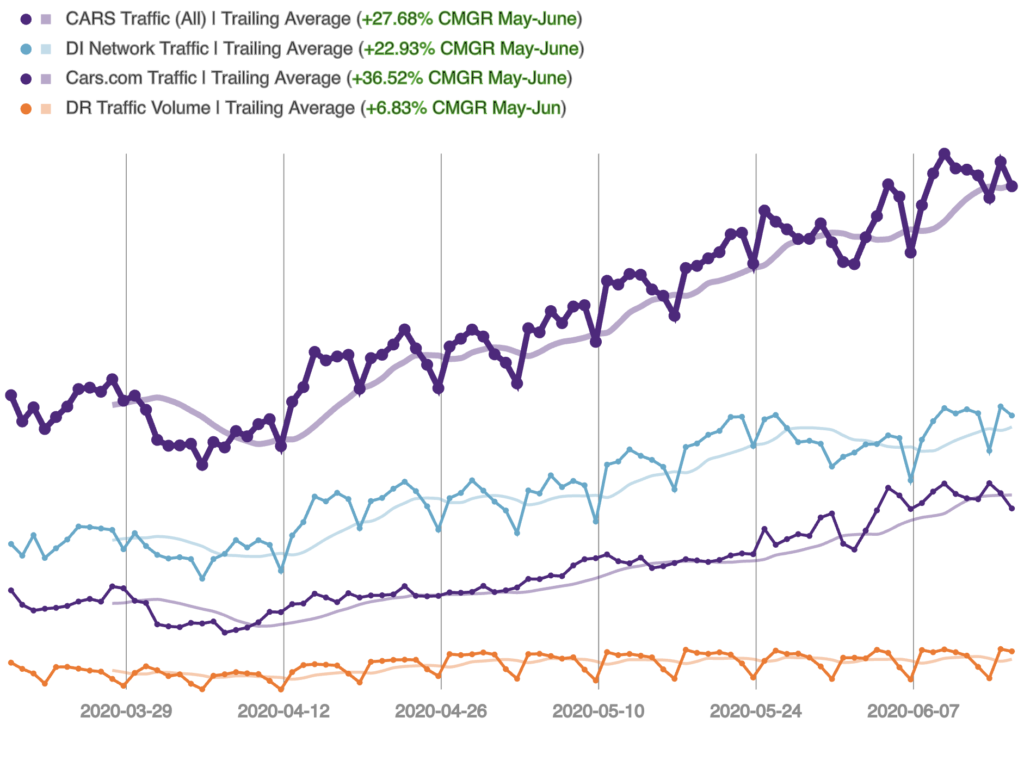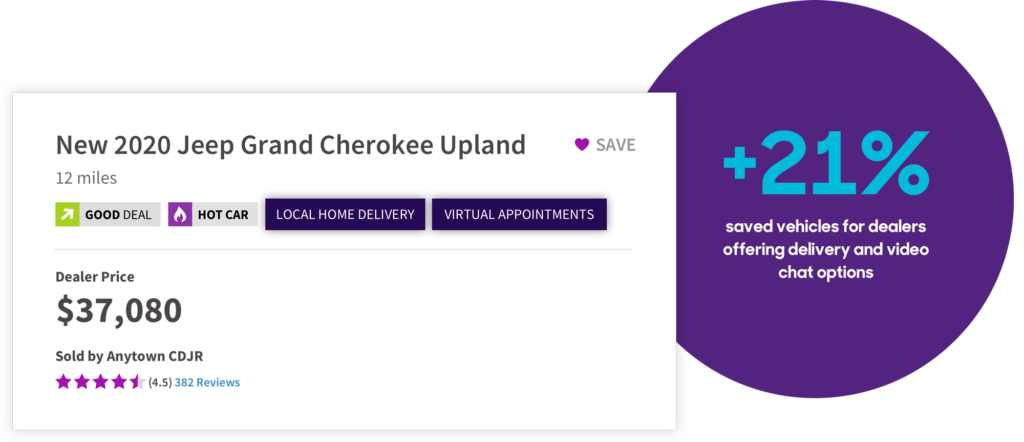And that’s just the tip of the iceberg. Also, there’s good news amid the change:

Join Our Dealer Panel
Earn rewards for providing your valuable feedback on our products and services.

Within just a matter of weeks, physical and digital showrooms have converged – dramatically. Dealerships everywhere are reporting an increase in online sales in 2020, including AutoNation, which reports that nearly half of its sales now occur online. On-the-lot visits and in-person selling is not going away – but digital has emerged as the front-and-center channel now for automotive retailing.
3/19/20 – 6/16/20

As consumers look to connect with dealers across the country, there is an increased desire for more digital and convenient services. Shoppers are motivated by new wants and needs: their cars are now a sanctuary and safeguard against riskier forms of getting around, such as public transportation and ridesharing. And a new generation of car buyers has been born: the pandemic has motivated nearly 20% of people who do not own a car to now consider purchasing one.
At the same time, in-market shoppers are buying differently in the era of social distancing, and they’re spending amid a backdrop of an economically challenging environment. How well a dealership can meet shoppers digitally and manage safety and cleanliness in the showroom and the service lane are critical factors influencing a consumer’s choice of dealership.
Dealerships are responding. Consider:

The fact is, automotive retailing was already going digital. COVID-19 accelerated that change. Now, as the automotive retailing industry rebounds from the initial shock of the global pandemic, every dealer has an opportunity to thrive in a new world where digital defines the experience.
Read on for five ways to do just that.
Your website is your digital front door to your business. As the automotive shopping journey continues to shift to digital, your website is your business.
That means dealers need to fundamentally shift your thinking around leads as an industry — especially because we’re seeing leads come roaring back with +103.3% increase across Cars.com, comparing the first of June MTD to the first week of April MTD. However with that increase in opportunities it’s imperative to view websites as way more than a lead generation machine now — and take the same level of customer service you expect in-store, online.
Imagine if a customer walked into your physical store interested to browse your inventory and discuss financing — and you gave them a clipboard with a form, asked them to fill it out, and then told them you’d be in touch sometime soon to answer their questions. Letting that shopper walk out of your physical store without trying to help them in the moment would be unthinkable. But that’s the experience many shoppers are having on a dealership’s website.
That’s why it’s critical to seamlessly pair your digital retailing tool with an advanced messaging platform that can simulate your customer service with instant answers, materials (vehicle details, brochures, videos), and live video chat to talk face-to-face. Just like you would in-store, you need to be able to sit down with him and talk through the specific financing options they are looking at and collaborate to close the deal. Make it easy.
If you don’t catch the online shopper in the moment, you should still treat them like a walk-in. That means not using the old lead form follow-up process. These shoppers have saved and customized specific vehicles and explored payment options. So, your follow-up needs to acknowledge that specific progress they made and seamlessly pick-up where they left off — just like they had an appointment with you yesterday and are now back in your showroom. Automated emails and uninformed phone calls will cause a total disconnect in their customer experience, making them feel like they need to start over. So treat them like walk-ins you already know.

The online customer journey has become more complicated than ever. A car shopper’s journey can span as many as 900 digital interactions – and that was before COVID-19 accelerated the path toward online purchasing. So, what’s the best path forward?
The answer: build bridges from the most valuable digital touchpoints to your website. For example, according to a recent Google case study, auto marketplaces drive new traffic to OEM and dealership sites (traffic that wasn’t already on your site in the past 30 days). The study found that almost two in three consumers who visited the OEM or dealer site and came through an auto marketplace had not previously visited in the past 30 days.
In addition, our own Roxanne data shows that Cars.com makes consumers four times more likely to visit your site and six times more likely to convert into a lead.
Those are strong bridges!
But those are not the only ones. You also need to, among other things:

The key is to have your inventory on the right channels and maximize inbound traffic flow to your digital lot.
Your offline experience isn’t going away. What’s changed is that now more than ever customers expect a seamless online to offline experience – and they are looking at your offline experience differently. Consumers are paying a premium for convenience – and safety – and expect a frictionless digital experience whether they are ordering home-delivered groceries or doing a virtual walk through of a home they plan to buy.
Dealers must help shoppers seamlessly navigate the path to purchase from their home to your dealership and then back to their homes by combining proven approaches (such as having a presence on a third-party site) with new ones (such as mastering home delivery).
For example, having a presence on a third-party platform not only drives in-market shoppers to your website – doing so also continues to send in-market shoppers to your physical dealership. In addition, by leaning into reputation management and salesperson review tools from companies like DealerRater, it makes it possible for your customers to familiarize themselves with your brand and your sales team and book an appointment on the lot ahead of time. This functionality is crucial now as shoppers are more carefully planning when they leave their homes and visit physical destinations. And we see that when a customer connects with a salesperson on digital channels ahead of coming to the physical lot, the leads close at a 2.5x higher conversion rate.
The pandemic has created more urgency for dealerships to now also build a bridge from their store to their customer’s driveway. Over the last few months, the number of dealers investing in home delivery and pick-up and drop-off services for their dealership is increasing rapidly. And with our local delivery badging you can now promote those services to in-market shoppers looking at your inventory.
Furthermore, a dealer’s website used to serve as a land grab for vendors creating an often cluttered and clunky experience for shoppers. Real estate on a dealer’s website is more precious than ever, and should focus on a simple experience that highlights the most important things a shopper wants to know: Are you open? What are your digital services? and How can I connect with you virtually?
Before COVID-19, $10 billion of U.S. automotive advertising spend went to traditional, untargeted TV – even though less than 5% of households in a local market were serious about buying a new or used vehicle (eMarketer, January 2020).
This kind of inefficient, wasteful spending is no longer acceptable in today’s climate. Now more than ever, your processes, platforms, and promotions need to be hyper-efficient.
Succeeding in today’s climate means spending smartly on connected digital platforms that make efficient use of audience data – data that makes it possible for you to target real in-market shoppers where they are in their journey. This could be when they are interacting with you on social, your website, a third-party marketplace or via streaming apps and connected TV.
Every single interaction – a chat, website visit, a click on an online ad — needs to be hyper connected through a common set of customer data. When you do that, you eliminate waste by using the highest-quality data to reach true in-market shoppers first and foremost – especially in the digital world.
How? By validating the shopper is in-market before dedicating the majority of your budget to them. By leveraging quality data to identify these shoppers and meet them where they spend the most time: on social platforms and with digital video on streaming TV apps and digital retargeting campaigns across the most-used websites.

It’s not enough to be present everywhere an in-market shopper may be. You need to learn from every interaction they have with you in order to reach them at the right place and time with the right experience.
A focused and connected marketing strategy must be complemented by a connected customer experience from online to offline. Now more than ever, dealerships should prioritize investments in technology that enable their salespeople to build trust with a customer, answer questions, provide a test drive or walk around of the car and even close a deal – virtually. If your sales team is not equipped with the technology that allows them to chat, text and conduct video calls, you are quickly falling behind.
At a time of continued uncertainty, businesses need to work harder to build trust and offer the best experience possible. And these things can be done in the digital world.
One way to build trust is to humanize your brand through your people. For instance:
Promote your brand story, not just offers. The automotive industry has been battling a race to the bottom for years. As dealers’ margins are squeezed even further, human capital is at a premium and car sales have slowed, it’s easy to interpret the direction of “focus on efficiency” to “only promote low-funnel messaging like incentives.” But don’t be mistaken; brand messaging has a valuable and effective role to play!
During the pandemic we found that digital video pre-roll campaigns that focused on a dealership’s brand and customer experience drove a 66% higher click-through rate compared to those that were exclusively offer based. The engagement levels on experience campaigns versus offer campaigns were even higher on social media. This is great news because it means that you can position yourself as more than your price in targeting these lower-funnel shoppers, and it will truly resonate with them.
Make it easy to meet and review salespeople online. Tools such as Salesperson Connect are designed to help shoppers find the right salesperson. The salesperson profiles include customer ratings, background about their interests, and other information that builds confidence and trust before you visit a dealership. This tool also humanizes the dealership’s brand through a familiar, friendly face. And shoppers who select a salesperson prior to coming into the dealership have an 89% higher closing rate.
Unleash your brand ambassadors. Having your sales team active on social media, including Facebook, Instagram, and YouTube, goes a very long way to humanizing your brand. A recent study says that half of Gen Z cannot live without YouTube. How well are your dealership’s brand ambassadors using YouTube to introduce themselves and your dealership, provide a tour of your inventory, and other content? How well are your salespeople using Facebook and Instagram at a personal level to do the same? When you unleash your brand ambassadors on social, you not only build trust, you create more bridges to your dealership.
Another huge way to build trust online is to create a better digital experience. For instance:
Building trust with a better experience also does something else: protects your margins. Your people and your customer service create a stronger brand.